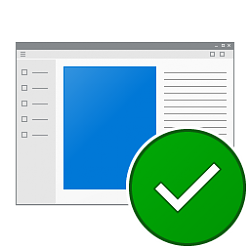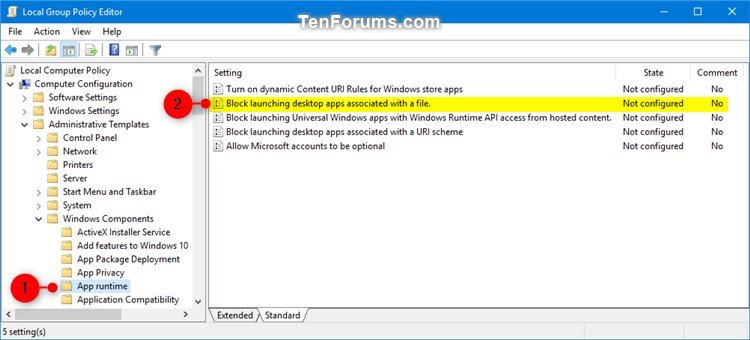How to Enable or Disable Microsoft Store Apps Open Files in Default Desktop App in Windows 10
If you like, you can configure a group policy setting that lets you control whether Microsoft Store apps can open files using the default desktop app for a file type. Because desktop apps run at a higher integrity level than Microsoft Store apps, there is a risk that a Microsoft Store app might compromise the system by opening a file in the default desktop app for a file type.
If you enable this policy setting, Microsoft Store apps cannot open files in the default desktop app for a file type; they can open files only in other Microsoft Store apps.
If you disable or do not configure this policy setting, Microsoft Store apps can open files in the default desktop app for a file type.
This tutorial will show you how to enable or disable Microsoft Store apps from being able to open files in the default desktop app for a file type for all users in Windows 8 and Windows 10.
- Option One: Enable or Disable Microsoft Store Apps Open Files in Default Desktop App using Local Group Policy Editor
- Option Two: Enable or Disable Microsoft Store Apps Open Files in Default Desktop App using a REG file
EXAMPLE: Message when Microsoft Store app not allowed to open a file in a desktop app set as the default app for this file type
The Local Group Policy Editor is only available in the Windows 10 Pro, Enterprise, and Education editions.
All editions can use Option Two below to set this policy.
1. Open the Local Group Policy Editor.
2. In the left pane of Local Group Policy Editor, navigate to the location below. (see screenshot below)
Computer Configuration/Administrative Templates/Windows Components/App runtime
3. In the right pane of App runtime in Local Group Policy Editor, double click/tap on the Block launching desktop apps associated with a file policy to edit it. (see screenshot above)
4. Do step 5 (enable) or step 6 (disable) below for what you would like to do.
A) Select (dot) Not Configured or Disabled, click/tap on OK, and go to step7 below. (see screenshot below)
Not Configured is the default setting.
7. If you like, you can now close the Local Group Policy Editor.
The downloadable .reg files below will add and modify the DWORD value in the registry key below.
HKEY_LOCAL_MACHINE\SOFTWARE\Microsoft\Windows\CurrentVersion\Policies\Associations
BlockFileElevation DWORD
(delete) = Enable
1 = Disable
1. Do step 2 (enable) or step 3 (disable) below for what you would like to do.
This is the default setting.
A) Click/tap on the Download button below to download the file below, and go to step 4 below.
Enable_Microsoft_Store_apps_open_files_using_default_desktop_app.reg
Download
A) Click/tap on the Download button below to download the file below, and go to step 4 below.
Disable_Microsoft_Store_apps_open_files_using_default_desktop_app.reg
Download
4. Save the .reg file to your desktop.
5. Double click/tap on the downloaded .reg file to merge it.
6. When prompted, click/tap on Run, Yes (UAC), Yes, and OK to approve the merge.
7. When finished, you can delete the downloaded .reg file if you like.
That's it,
Shawn
Related Tutorials
- How to Choose Default Apps to Open Files with in Windows 10
- How to Choose Where Apps can be Installed from in Windows 10
- How to Use AppLocker to Allow or Block Executable Files from Running in Windows 10
Enable or Disable Microsoft Store Apps Open Files in Desktop App

Enable or Disable Microsoft Store Apps Open Files in Desktop App
How to Enable or Disable Microsoft Store Apps Open Files in Default Desktop App in Windows 10Published by Shawn BrinkCategory: Apps & Features
13 Jan 2019
Tutorial Categories


Related Discussions





